1.前言
最近需要用到卷积神经网络(CNN),在还没完全掌握cuda+caffe+TensorFlow+python这一套传统的深度学习的流程的时候,想到了matlab,自己查了一下documentation,还真的有深度学习的相关函数。所以给自己提个醒,在需要用到某个成熟的技术时先查一下matlab的帮助文档,这样会减少很多时间成本。记得机器学习的大牛Andrew NG.说过在硅谷好多人都是先用matlab/octava先实现自己的想法,再转化成其他语言。
2.配置需求
要像用matlab实现deep learning,需要更新到2017a版本。GPU加速的话,需要安装cuda8.0, 自己GPU 的compute capacity 要3.0 以上。
3. 可以完成的任务
我们看一下matlab的新加的深度学习功能可以完成哪些任务
1. 获取别人训练好的CNN网络 2. 迁移学习(transfer learning and fine-tune) 3. 解决分类问题(classifiy problem) 4. 解决回归问题(regression problem) 5. 物体检测(object detection) 6. 提取学习到的特征
- 1
- 2
- 3
- 4
- 5
- 6
- 7
3.1 获取别人训练好的网络
matlab2017中,可以用别人训练好的现成的网络,也可以输入caffe中的网络。目前已知的可以用的网络包括用于分类的:Alexnet, vgg16, vgg19。已经用于物体检测的,RCNN, FastRCNN, Faster RCNN。由于最近一直研究的是分类和回归问题,物体检测的CNN在过后补全。这里只举一个分类的例子。
Alexnet作为2012年ImageNet的冠军,它的提出确实影响到了CV的研究热点,人们惊奇的发现深度网络的描述能力居然这么强,虽然背后的数学原理一直没能得到完美的解决,但不妨碍它强大的能力,我们看看她在matlab中是如何做分类的。首先贴出代码:
clear;clc;close all;
%获取alexnet
net = alexnet;
%读照片选物体
I= imread('peppers.png');
[cropedim, rect2]=imcrop(I);
cropedim=imresize(cropedim,[227 227]);
figure,imshow(cropedim);
% 用AlexNet分类
label = classify(net, cropedim);
% 显示结果
figure;
imshow(I);
rectangle('position',rect2,'EdgeColor','r','LineWidth',2);
text(10,20,char(label),'Color','white','FontSize',20);- 1
- 2
- 3
- 4
- 5
- 6
- 7
- 8
- 9
- 10
- 11
- 12
- 13
- 14
- 15
用matlab自带的照片测试一下分类的准确率,得到的结果如下
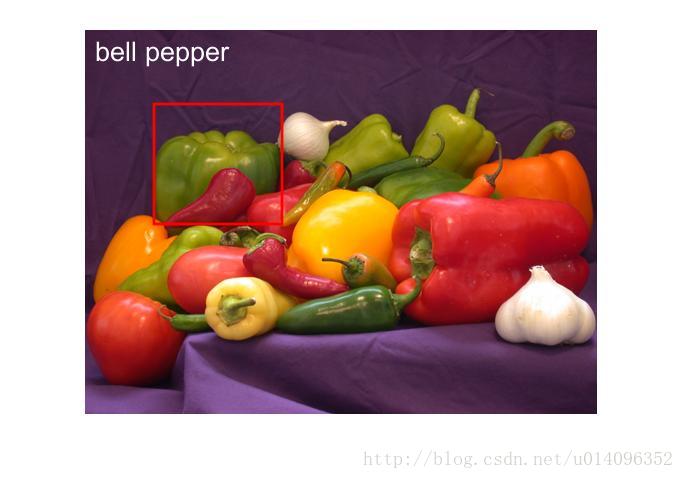
bell pepper是甜椒的意思,我们发现效果还是不错的,感兴趣的同学可以多找几张测试图片试一下。用
net.Layers- 1
命令可以看Alnexnet的网络结构,得到以下

这是一个25层的网络,每一层都对应着详细的说明。值得关注的是有5个卷积层(convolution layer)和三个全连接层(full connection layer)。其他的vgg16和vgg19是相同的道理,不过要看清楚网络的输入,使用vgg19时,需要改变上边代码中的两行
net = vgg19;
cropedim=imresize(cropedim,[224 224]);- 1
- 2
剩下的部分是一样的。当然也可以从caffe中导入自己训练好的网络,自己还没有完全掌握caffe,熟悉这部分的同学可以自己实现一下。
3.2 迁移学习(transfer learning and fine-tune)
所谓迁移学习(transfer learning)就是微调(fine-tune)别人训练好的网络中的某些参数,使得它更适合自己的数据集。迁移学习使用的情况是:几百到几千个训练样本,想快速训练网络。网络的训练过程就是刚开始为各个参数赋予随机的值,采用数值的方法(一般是梯度下降法)求让cost function 达到最小值的各个参数的取值,这些参数主要产生于各个层之间连接时候的权值。Cost function是标定好的数据与通过网络计算出的数据的差的累加。Cost function越小说明网络的性能越好。我们看看matlab中是如何用现有的网络做迁移学习的,我们举一个手写体识别的例子,其中matlab自己提供了训练集和测试集。先贴出代码:
%% transfer learning
%读取训练集和测试集
digitDatasetPath = fullfile(matlabroot,'toolbox','nnet','nndemos', ...
'nndatasets','DigitDataset');
digitData = imageDatastore(digitDatasetPath, ...
'IncludeSubfolders',true,'LabelSource','foldernames');
[trainDigitData,testDigitData] = splitEachLabel(digitData,0.5,'randomize');
%显示前20个训练照片
numImages = numel(trainDigitData.Files);
idx = randperm(numImages,20);
for i = 1:20
subplot(4,5,i)
I = readimage(trainDigitData, idx(i));
imshow(I)
end
% 获取matlab自己训练好的网络
load(fullfile(matlabroot,'examples','nnet','LettersClassificationNet.mat'))
% 改变输出层的类别个数
layersTransfer = net.Layers(1:end-3);
% 显示新的类别个数
numClasses = numel(categories(trainDigitData.Labels));
% 把最后三层替换成新的类别
layers = [...
layersTransfer
fullyConnectedLayer(numClasses,'WeightLearnRateFactor',20,'BiasLearnRateFactor',20)
softmaxLayer
classificationLayer];
optionsTransfer = trainingOptions('sgdm',...
'MaxEpochs',5,...
'InitialLearnRate',0.0001,...
'ExecutionEnvironment','cpu');
% 训练网络
netTransfer = trainNetwork(trainDigitData,layers,optionsTransfer);
% 显示测试准确率
YPred = classify(netTransfer,testDigitData);
YTest = testDigitData.Labels;
accuracy = sum(YPred==YTest)/numel(YTest);
% 显示测试结果
idx = 501:500:5000;
figure
for i = 1:numel(idx)
subplot(3,3,i)
I = readimage(testDigitData, idx(i));
label = char(YTest(idx(i)));
imshow(I)
title(label)
end- 1
- 2
- 3
- 4
- 5
- 6
- 7
- 8
- 9
- 10
- 11
- 12
- 13
- 14
- 15
- 16
- 17
- 18
- 19
- 20
- 21
- 22
- 23
- 24
- 25
- 26
- 27
- 28
- 29
- 30
- 31
- 32
- 33
- 34
- 35
- 36
- 37
- 38
- 39
- 40
- 41
- 42
- 43
- 44
- 45
- 46
- 47
- 48
- 49
- 50
- 51
代码的前边的部分是读取matlab中自带的数据集和测试集,把它保存成imageDatastore格式,这种格式只需要提供图片的路径信息而不用把图片全部读入内存中,因此非常适合大规模的数据集。中间部分是修改训练好的网络中的最后三层,原网络用来识别手写的字母和数字有36类,而现在的任务只需要识别手写体数字,所以把它们改成10类,在训练时使用0.0001的学习率,共计算5轮,用cpu做训练。代码的最后部分是测试新训练好的网络,因为transfer learn是在现有的网络基础上做参数的微调,所以训练速度很快,我们看一下训练效果。

由于是在cpu上做的训练,而且是transfer learning 所以训练的过程很快,我们发现重新训练好的网络能达到很高的准确率。我们再看gpu上的训练

由于参数的初始化是随机的,因此得到的结果也是随机的,不过可以看出gpu上做训练明显要快很多!GPU的第一轮计算慢是因为数据要重新初始化为gpu矩阵。最后放一张效果图:
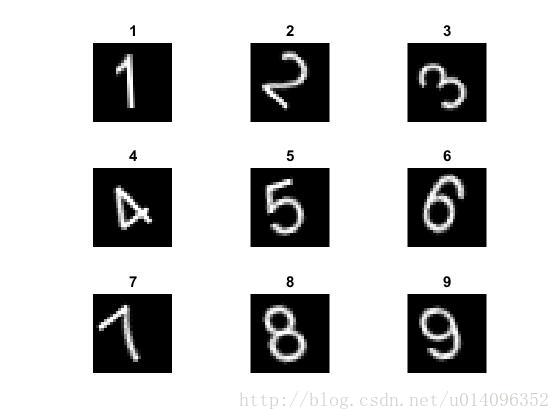
我们发现识别的效果还是不错的。
3.3 分类问题(classification problem)
CNN之所以能引起广泛关注,就是在于它最初在图像分类方面取得很大的成功,后来人们发现对于其他的分类问题,CNN也有很好的性能。上边讲的迁移学习解决的也是一种分类问题,接下来的叙述也就建立在上文的基础上。
我们这里要解决的分类问题,就是训练自己的分类网络。之前的迁移学习已经说明,所谓训练就是为每层网络之间寻找使得cost function最小的权值,这些权值刚开始是按照某种分布随机初始化的,我们用数值的方法求cost function的最小值。一般来说,我们用神经网络建立的是一个非常复杂的模型,我们往往能难找到这个模型的最小值,但可以找到它的极小值(局部最小值),这些极小值已经很接近我们要找到最小值。
要训练自己的网络,我们要先建立自己的网络,并设置一定的训练参数。我们看一下matlabs是如何完成的。
在matlab中用来建立网络的语句如下:
layers = [ ...
imageInputLayer([imsize imsize 1])
convolution2dLayer(5,150)
reluLayer
crossChannelNormalizationLayer(5,'Alpha',0.00005,'Beta',0.75,'K',1) %Norm layer1
convolution2dLayer(3,300,'Stride',1,'BiasLearnRateFactor',2) %Cov2 layer
reluLayer
fullyConnectedLayer(1)
softmaxLayer
classificationLayer];
- 1
- 2
- 3
- 4
- 5
- 6
- 7
- 8
- 9
- 10
- 11
直接用数组建立网络,这个例子是建立一个9层的分类网络,包括输入层,卷积层1,激活函数层1,标准化层,卷积层2,激活函数层2,全连接层,去最大值层,分类层。至于如何选择适合自己的网络结构,我目前还没有搞太清楚,不过,可以现在别人的网络基础上做修改。
用来设定修改参数的语句如下:
options = trainingOptions('sgdm', ...
'MaxEpochs',15, ...
'InitialLearnRate',1e-4, ...
'MiniBatchSize',256,...
'ExecutionEnvironment','gpu');
'OutputFcn',functions);- 1
- 2
- 3
- 4
- 5
- 6
这些参数是CNN网络的基本参数,MaxEpoch是计算的轮数,它的值越大越容易收敛,InitialLearRate是学习率,太大模型可能不会收敛,太小则收敛的太慢。MiniBatchSize是每次处理的数据的个数,ExcutionEnviroment是训练网络的环境,可以在CPU(‘cpu’)上做,也可在GPU(‘gpu’)上做,可以并行(‘paralle’),默认的情况是先测试gpu,如果不可用在测试gpu。在matlab上用gpu训练网络时需要cuda8.0, 显卡计算能力为3.0。这些参数可以用指令gpuDevice来查看。OutputFcn是可以在训练过程中调用的某些函数。比如:它可以用来画cost function值的变化。如何像可视化训练表格(上文输出的那些)某些数据可以调用相应的函数,我在回归问题时会再说明。
设定好网络结构和训练参数后,可以用
net = trainNetwork(trainData,layers,options);- 1
来训练自己的网络,训练数据可以是ImageDatastore类型,可以是4-D数组,四个维度分别是长度,宽度,通道数,第几个图片。因为4-D数组是一次性装入到内存中的,如果数据量太大时慎用,小心内存不足。同样,我们举一个完整的例子,也是利用matlab自带的数据集去分类手写体。代码如下:
%读取数据集并保存成imageDatastore形式
digitDatasetPath = fullfile(matlabroot,'toolbox','nnet','nndemos',...
'nndatasets','DigitDataset');
digitData = imageDatastore(digitDatasetPath,...
'IncludeSubfolders',true,'LabelSource','foldernames');
%随机显示二十个训练集中的图片
figure;
perm = randperm(10000,20);
for i = 1:20
subplot(4,5,i);
imshow(digitData.Files{perm(i)});
end
%把数据集划分成训练集和测试集
trainingNumFiles = 750;
rng(1) % For reproducibility
[trainDigitData,testDigitData] = splitEachLabel(digitData,...
trainingNumFiles,'randomize');
%建立自己的网络
layers = [imageInputLayer([28 28 1]);
convolution2dLayer(5,20);
reluLayer();
maxPooling2dLayer(2,'Stride',2);
fullyConnectedLayer(10);
softmaxLayer();
classificationLayer()];
%设定训练参数
options = trainingOptions('sgdm','MaxEpochs',20,...
'InitialLearnRate',0.0001);
%训练网络
convnet = trainNetwork(trainDigitData,layers,options);
%测试网络
YTest = classify(convnet,testDigitData);
TTest = testDigitData.Labels;
accuracy = sum(YTest == TTest)/numel(TTest);
disp(accuracy);
- 1
- 2
- 3
- 4
- 5
- 6
- 7
- 8
- 9
- 10
- 11
- 12
- 13
- 14
- 15
- 16
- 17
- 18
- 19
- 20
- 21
- 22
- 23
- 24
- 25
- 26
- 27
- 28
- 29
- 30
- 31
- 32
- 33
- 34
- 35
- 36
我自己的训练结果如下:

自己是在gpu上做的,所以时间较短,最后得到分类准确率发现还不错。
3.4 回归问题(regression problem)
回归问题与分类问题的处理方式相同,我们仍然需要训练集和测试集。在网路结构上有些不同,最后一次必须是Regression layer, 而倒数第二次必须是卷积层。回归问题的网络中的参数与分类问题是一样的,这里不再详细说明,我们直接分析一个例子,看一下matlab是如何做分类的。这个问题同时看一下function参数的作用。这次要解决的问题是,图片中的字母到底旋转了多少度。数据集同样来自matlab代码如下:
%读取数据集
[trainImages,~,trainAngles] = digitTrain4DArrayData;
%显示任意二十个结果
numTrainImages = size(trainImages,4);
figure
idx = randperm(numTrainImages,20);
for i = 1:numel(idx)
subplot(4,5,i)
imshow(trainImages(:,:,:,idx(i)))
drawnow
end
%建立回归网络
layers = [ ...
imageInputLayer([28 28 1])
convolution2dLayer(12,25)
reluLayer
fullyConnectedLayer(1)
regressionLayer];
%设置训练参数
functions={...
@plotTrainingRMSE,...
@(info)stopTrainingAtThreshold(info,0)};
options = trainingOptions('sgdm', ...
'MaxEpochs',20, ...
'InitialLearnRate',1e-3, ...
'MiniBatchSize',128,...
'ExecutionEnvironment','gpu',...
'OutputFcn',functions);
%训练网络
net = trainNetwork(trainImages,trainAngles,layers,options);
%测试网络
[testImages,~,testAngles] = digitTest4DArrayData;
predictedTestAngles = predict(net,testImages);
%查看拟合误差
predictionError = testAngles - predictedTestAngles;
thr = 10;
numCorrect = sum(abs(predictionError) < thr);
numTestImages = size(testImages,4);
accuracy = numCorrect/numTestImages;
disp('accuracy');
disp(accuracy);
squares = predictionError.^2;
rmse = sqrt(mean(squares));
disp('the rmse');
disp(rmse);
%train function
function plotTrainingRMSE(info)
persistent plotObj
if info.State == "start"
figure;
plotObj = animatedline;
xlabel("Iteration")
ylabel("Training RMSE")
elseif info.State == "iteration"
addpoints(plotObj,info.Iteration,double(info.TrainingRMSE))
drawnow limitrate nocallbacks
end
end
function stop = stopTrainingAtThreshold(info,thr)
stop = false;
if info.State ~= "iteration"
return
end
persistent TrainingRMSE
% Append accuracy for this iteration
T= info.TrainingRMSE;
% Evaluate mean of iteration accuracy and remove oldest entry
stop = T <thr;
end- 1
- 2
- 3
- 4
- 5
- 6
- 7
- 8
- 9
- 10
- 11
- 12
- 13
- 14
- 15
- 16
- 17
- 18
- 19
- 20
- 21
- 22
- 23
- 24
- 25
- 26
- 27
- 28
- 29
- 30
- 31
- 32
- 33
- 34
- 35
- 36
- 37
- 38
- 39
- 40
- 41
- 42
- 43
- 44
- 45
- 46
- 47
- 48
- 49
- 50
- 51
- 52
- 53
- 54
- 55
- 56
- 57
- 58
- 59
- 60
- 61
- 62
- 63
- 64
- 65
- 66
- 67
- 68
- 69
- 70
- 71
- 72
- 73
- 74
- 75
- 76
- 77
- 78
- 79
- 80
- 81
得到的回归结果如下:
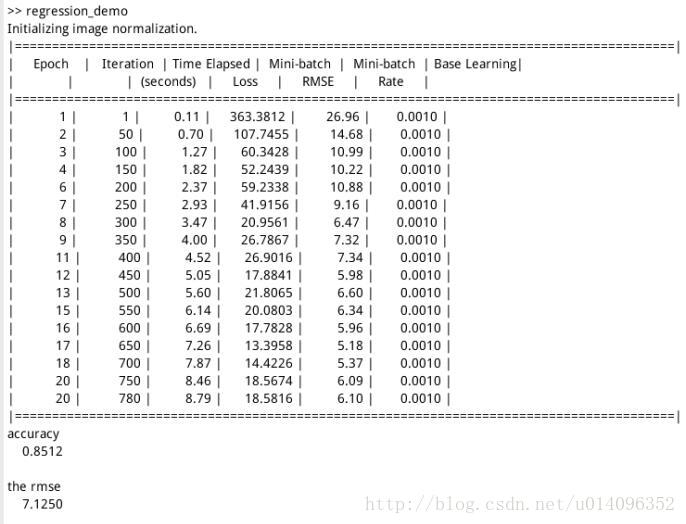
我们在训练过程中调用两个函数,plotTrainingRMSE是用来画cost function是如何变化的,(info)stopTrainingAtThreshold(info,0)是设置训练提前结束的条件的,可以根据表中的某些参数让训练在一定条件下停下来。最后,我们看一下cost function 的变换规律,如下:
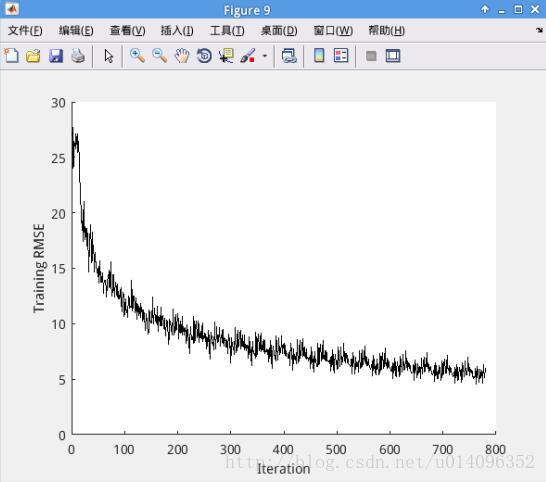
目前为止,我们用cnn解决了最基本的分类问题和回归问题,此外,还介绍了如何建立网络和设定参数,后边将补充检测部分。
3.3 检测问题(Detection problem)
同样用matlab自带数据集做车辆检测,关于检测的网络有RCNN, Fast RCNN, Faster RCNN, 他们大同小异,差距在于速度的快慢,我们只测试Faster RCNN
1) 读取数据
data = load('fasterRCNNVehicleTrainingData.mat');- 1
data是个结构体类型的数据,主要是用来四个属性分别是detector, layers, result, vehicleTraining.
其中,detector, layers, reault是提前训练好的检测子,网络和测试结果,我们用vehicleTraining重新训练CNN网络,用layers来设计网络结构
2) 抽取用于训练的图像
trainingData = data.vehicleTrainingData;
trainingData.imageFilename=fullfile(toolboxdir('vision'),'visiondata',...
trainingData.imageFilename);
- 1
- 2
- 3
- 4
抽取出的trainingData是table格式的,matlab训练网络RCNN网络只能用table格式。
3) 读取网络结构
layers=data.layers;- 1
该网络是个11层的网络,训练时我们可以设计自己的网络结构,也可以在这个网络的基础上做训练。
4) 设置训练选项
options = trainingOptions('sgdm', ...
'InitialLearnRate',1e-6,...
'MaxEpochs',1,...
'ExecutionEnvironment','gpu',...
'CheckpointPath',tempdir);
- 1
- 2
- 3
- 4
- 5
- 6
这里设置的是初始学习率为 1e-6, 迭代1轮,用GPU做训练,在训练时会把checkpoint的结果存下来。
5) 训练网络
detector = trainFasterRCNNObjectDetector(trainingData,layers,options);- 1
用trainingData做训练数据,训练layers网络,在训练过程中选择option中的训练参数,同样用了GPU做训练,其中的一步如下:
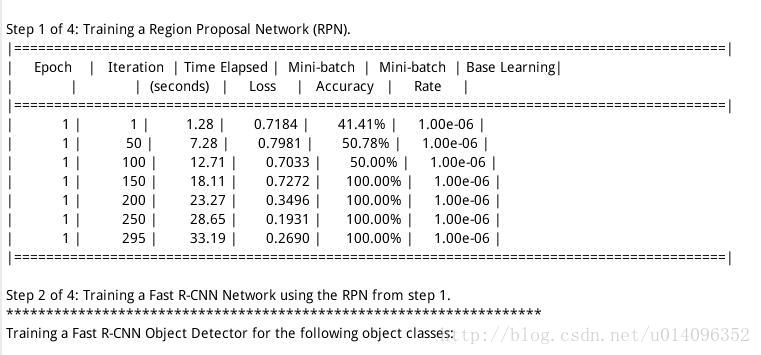
6) 结果检测
img=imread('highway.png');
[bbox,score,label]=detect(detector,img);
detectedImg=insertShape(img,'Rectangle',bbox);
figure,imshow(detectedImg);
- 1
- 2
- 3
- 4
- 5
从Matlab自身图库中选择hightway这张照片,用刚才训练出的网络监测里边的车辆,其中bbox是监测出的包围盒的坐标,这个可以用来返回。
这结果显示如下:
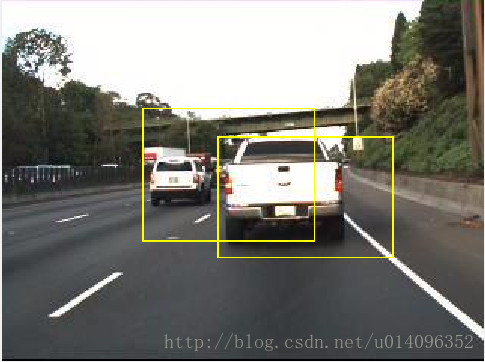

























 12万+
12万+

 被折叠的 条评论
为什么被折叠?
被折叠的 条评论
为什么被折叠?








